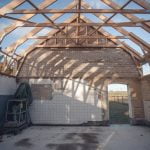Are you wondering where to put home improvements on taxes? Homeowners often seek ways to maximize tax benefits when it comes to renovating or upgrading their homes. Understanding what qualifies as a home improvement for tax purposes is crucial in ensuring that you can potentially save money through deductions.
When it comes to taxes, not all home expenses are treated equally. Differentiating repairs from improvements is essential as they have different tax implications. While repairs are considered routine maintenance and are not deductible, improvements that add value or prolong the life of your home may be eligible for tax deductions.
Keeping track of documentation and proof of home improvement costs is vital for claiming these expenses on your taxes. Whether you hire professionals for renovations or undertake DIY projects, maintaining detailed records will help support your claims and ensure compliance with tax laws. This meticulous record-keeping can ultimately save you money in the long run.
Differentiating Repairs From Improvements
When it comes to home improvements and taxes, one crucial aspect to consider is how repairs differ from improvements in terms of tax implications. In the eyes of the IRS, repairs are usually considered routine maintenance tasks that are necessary to keep your home in good condition.
These can include fixing a leaky roof, repairing a broken window, or patching up cracks in the walls. On the other hand, home improvements are enhancements made to increase the value of your property, such as adding a new bathroom, renovating a kitchen, or installing energy-efficient windows.
The key distinction between repairs and improvements lies in how they are treated for tax purposes. While repairs are generally deductible as expenses in the year they were incurred, home improvements may not be fully deductible right away.
Instead, the cost of improvements is typically added to your home’s basis, which is used to calculate potential capital gains when you sell your property. Understanding this difference is essential to ensure that you properly report your expenses and take advantage of any available tax benefits.
In order to accurately differentiate between repairs and improvements for tax purposes, it is crucial to keep detailed documentation of all work done on your home. This includes invoices from contractors, receipts for materials purchased, permits obtained for renovations, and any before-and-after photos that showcase the changes made. By maintaining organized records of your home improvement projects, you can easily track costs and prove their eligibility for potential tax deductions or credits related to homeownership.
| Repair vs Improvement | Tax Implications |
|---|---|
| Repairs | Deductible as expenses in the year incurred |
| Improvements | Added to home’s basis for potential capital gains calculation |
Keeping Track
When it comes to claiming home improvements on your taxes, one of the most crucial aspects is keeping track of all the documentation and proof of costs associated with the upgrades made to your home. This includes any receipts, invoices, contracts, and other relevant paperwork that validates the expenses incurred during the improvement process. Additionally, maintaining detailed records can help substantiate your claims in case of an audit by the IRS or any other tax authority.
Importance of Detailed Documentation
Having accurate documentation not only helps you accurately report home improvement costs on your taxes but also ensures that you are eligible for any potential deductions or credits related to these improvements. By keeping all receipts and records organized, you can easily reference them when preparing your tax return and provide necessary evidence to support your claims. Whether you hire contractors for renovations or undertake DIY projects, proper documentation is key in maximizing tax benefits.
Organizing Your Home Improvement Records
To streamline the process of claiming home improvements on your taxes, consider creating a separate file specifically dedicated to storing all related documents. This can include before-and-after photos, permits obtained for the work done, material purchase receipts, labor costs, and any other relevant information that showcases the extent and value of the improvements made to your property.
By staying organized throughout the year and consistently updating this file as new projects are completed, you will be well-prepared come tax season. Remember, being proactive in documentation will ultimately save you time and hassle when it’s time to report these expenses on your tax return.
Taking Advantage of Tax Deductions
When it comes to home improvements, many homeowners often overlook the potential tax benefits that can come with making upgrades to their property. Understanding how home improvements can save you money through tax deductions is key to maximizing the financial impact of your renovation projects. By taking advantage of these tax benefits, you can not only improve your living space but also reduce your overall tax liability.
Types of Tax Deductions for Home Improvements
There are several ways in which home improvements can qualify for tax deductions. One common deduction is the energy-efficient home improvement tax credit, which allows homeowners to claim a percentage of the cost of qualifying energy-efficient upgrades, such as solar panels or energy-efficient windows. Another deduction to consider is the medical home improvement deduction, which allows individuals with certain medical conditions to deduct the cost of necessary home modifications.
Maximizing Your Tax Savings
To ensure that you are maximizing your tax savings from home improvements, it is important to keep detailed records of all expenses related to your renovation projects. This includes receipts, invoices, and any other documentation that can serve as proof of the costs incurred. By staying organized and maintaining accurate records, you can easily track your expenses and ensure that you are claiming all eligible deductions on your tax return.
Consulting a Tax Professional
Navigating the complexities of tax deductions for home improvements can be challenging, especially for those who are not familiar with tax laws and regulations. To make sure you are taking full advantage of all available deductions and credits, consider consulting a qualified tax professional who can provide guidance on where to report home improvements on your taxes and help you maximize your savings.
With proper planning and assistance from a professional, you can make the most out of your home improvement projects from both a financial and tax perspective.
The Importance of Knowing Your Basis
When it comes to understanding how home improvements can affect your taxes, one crucial aspect to consider is how these upgrades impact the basis of your home. The basis of your home is essentially the amount you paid for it, including any additional costs like improvements. By knowing your basis, you can determine the capital gains taxes you may owe when you sell your home.
For example, if you purchased your home for $200,000 and then invested $50,000 in renovations, your new basis would be $250,000. When you eventually sell your home for $300,000, the capital gains tax would only apply to the $50,000 gain ($300,000 – $250,000). This showcases how properly accounting for home improvements and understanding their effect on your basis can significantly impact your tax obligations in the future.
In order to accurately calculate the impact of home improvements on your basis and potential taxes owed upon sale, it is essential to keep detailed records. Make sure to retain invoices, receipts, and any other documentation related to the costs incurred during the improvement process. This documentation will not only help support your claims in case of an audit but also enable you to accurately track your basis over time.
Where to Report Home Improvements on Your Taxes
When it comes to reporting home improvements on your taxes, knowing the right place to claim them is essential for maximizing potential tax benefits. Homeowners often wonder whether they should use Schedule A or Form 5695 when it comes to claiming their home improvement expenses. Understanding the difference between these two forms can help you make an informed decision on where to put home improvements on taxes.
To determine where to report your home improvements, you need to consider the type of improvement you made and whether it qualifies for a tax deduction or credit. For most general home improvement expenses, such as remodeling a kitchen or bathroom, you will typically report these on Schedule A (Form 1040). This form allows you to itemize deductions for things like mortgage interest, property taxes, and certain qualified medical expenses.
On the other hand, if your home improvements are related to energy efficiency upgrades, such as installing solar panels or energy-efficient windows, you may be eligible for tax credits under Form 5695. This form specifically deals with residential energy credits and can help offset some of the costs associated with making your home more energy-efficient. Make sure to keep detailed records of all expenses related to these improvements for proper documentation when filing your taxes.
To ensure accuracy in reporting your home improvement expenses on your taxes, consult with a tax professional or use tax preparation software that can guide you through the process. By understanding where to put home improvements on taxes and taking advantage of available deductions and credits, you can potentially save money while increasing the value of your home at the same time.
Additional Tax Credits and Incentives for Energy-Efficient Home Improvements
One way to maximize the benefits of home improvements on your taxes is by taking advantage of additional tax credits and incentives for energy-efficient upgrades. These incentives are designed to promote sustainability and reduce energy consumption, benefiting both homeowners and the environment. Here are some of the tax credits and incentives you may be eligible for:
- Residential Energy Efficiency Property Credit: This credit allows homeowners to claim a percentage of the cost of qualifying energy-efficient improvements, such as solar panels, geothermal heat pumps, and small wind turbines.
- Non-Business Energy Property Credit: This credit covers a portion of the costs associated with installing eligible residential energy property like insulation, windows, doors, and certain roofing materials that meet specified efficiency criteria.
- Energy-Efficient Mortgage (EEM): An EEM can help you qualify for a larger loan amount when purchasing an energy-efficient home or refinancing your existing mortgage to make energy-saving improvements.
By taking advantage of these tax credits and incentives, you not only reduce your tax liability but also contribute to a greener future. It’s important to research eligibility requirements and keep detailed records of expenses related to energy-efficient home improvements in order to take full advantage of these opportunities.
Remember that these tax credits are subject to change based on legislation, so it’s essential to stay updated on current guidelines and regulations. Consulting with a tax professional can also provide valuable insights on where to put home improvements on taxes for maximum benefit. With careful planning and strategic implementation, you can make your home more sustainable while saving money on your taxes.
Potential Audit Red Flags
When it comes to claiming home improvements on your taxes, it’s crucial to be aware of potential audit red flags that could arise. By understanding these red flags and taking the necessary steps to avoid them, you can prevent any issues with the IRS and ensure that you receive the tax benefits you are entitled to.
One common red flag is not properly documenting or proving the costs of your home improvements. Without accurate records, the IRS may question the validity of your claims and potentially disallow any deductions or credits you are seeking. To avoid this issue, it is essential to keep detailed documentation of all expenses related to your home improvements, including receipts, invoices, and contracts.
Another red flag to watch out for is claiming excessive or unrealistic amounts for home improvement deductions. The IRS may scrutinize unusually high deduction amounts in comparison to your income level or property value, leading to a potential audit. To mitigate this risk, make sure that your claimed deductions are reasonable and supported by legitimate costs incurred for actual home improvements.
Remembering where to report home improvements on your taxes, whether on Schedule A or Form 5695, can also help streamline the process and minimize any errors or discrepancies in your tax return. By following these tips and staying informed about how to properly claim home improvements on your taxes, you can maximize your tax benefits while avoiding potential audit red flags.
Frequently Asked Questions
Can I Claim Home Improvements on My Tax Return?
Home improvements, such as renovations or repairs, are typically not deductible on your tax return. However, if the improvement increases the value of your home, it may be factored into the home’s cost basis when you sell.
Are Improvements to Home Office Tax Deductible?
Improvements to a home office can be tax deductible under certain circumstances. The IRS allows for a deduction if the space is used exclusively and regularly for business purposes. The expenses must be directly related to the office.
What Capital Improvements Are Tax Deductible?
Capital improvements that increase the value of your property may be tax deductible when you sell your home. This could include additions, landscaping, or major repairs that extend the life of the property. Keep detailed records of these expenses for tax purposes.

I’m thrilled to have you here as a part of the Remodeling Top community. This is where my journey as an architect and remodeling enthusiast intersects with your passion for transforming houses into dream homes.





